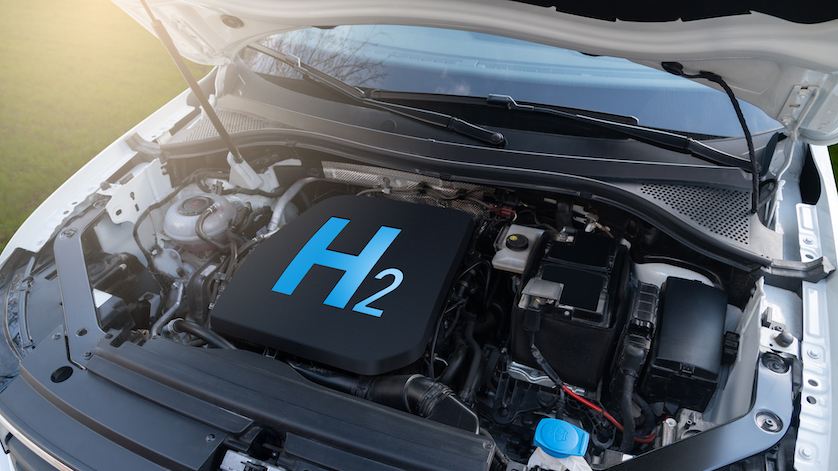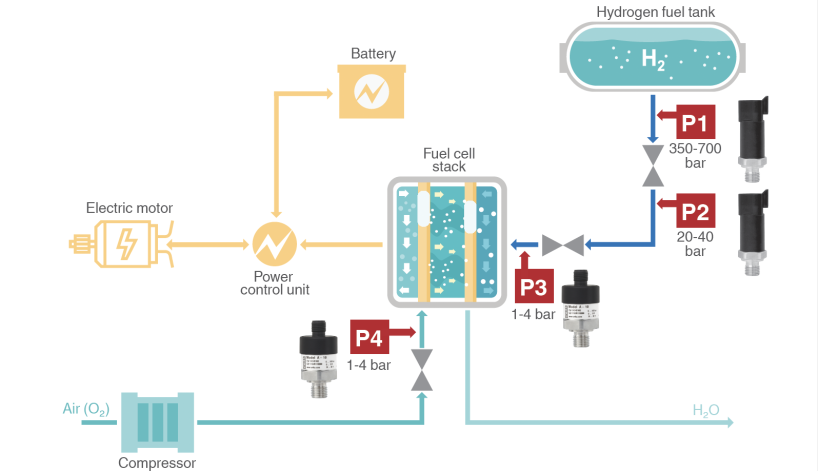
WIKA has agreements with three US-based leaders in hydrogen mobility to supply them with customer-specific versions of our high-quality hydrogen-compatible pressure sensors for their fuel cell systems.
The market for electric industrial vehicles continues to grow, as warehouses and shipping ports move away from internal combustion engines in order to reduce the emissions that harm personnel and the planet. While battery-powered material handlers like plug-in forklifts do not produce greenhouse gases, they do take about eight hours to charge for eight hours of operating time, as well as an eight-hour cool down time before running again.
On the other hand, hydrogen-powered vehicles refuel as quickly as machinery that are powered by gasoline, diesel, or natural gas. A fast H2 refueling process means less downtime and greater productivity, all while producing zero emissions.
Where to Measure Pressure in Hydrogen-Powered Vehicles
The hydrogen tank of a fuel cell electric vehicle (FCEV) is under very high pressure, as H2 is the lightest gas in the universe, and significant compression is necessary to carry sufficient quantities of the fuel onboard. The higher the pressure, the more hydrogen the vehicle can carry, and the longer its range.
From the dispenser of a hydrogen fueling station, H2 is pumped into the vehicle’s tanks at anywhere from 350 to 700 bar. The fuel cell stack cannot use hydrogen at such high pressures, so a series of regulators step down the gas to the hydrogen fuel cell operating pressure of 1 to 4 bar. Pressure sensors at the P1, P2, and P3 points monitor and control the decompression process, while another one at P4 controls the air intake pressure, which is also at 1 to 4 bar.

Where to measure pressure in hydrogen-powered vehicles
The Need for Hydrogen-Compatible Pressure Sensors
Not just any pressure sensor will do for FCEVs. Measurement instruments for a hydrogen economy must be able to resist hydrogen permeation and embrittlement, conditions that can cause sensors to drift and fail. The materials that resist permeation include:
- Austenitic stainless steel such as 316L and 316 Ti
- Special alloys such as Hastelloy C276, Inconel 718, or 2.4711 (Elgiloy®)
Customer-Specific Pressure Sensors for Fuel Cell Systems OEMs
WIKA recently signed annual agreements with three US-based companies that make and install fuel cell systems for on-road and off-road industrial FCEVs. We manufactured the following products to their precise specifications:
Manufacturer #1: MH-3-HY pressure sensors for forklifts
- Location of sensor: P1
- Measuring range: 0…450 bar
- Electrical connector: Deutsch DT04-3P
- Thread connection: 7/16″ -20 UNF SAE O-Ring Boss
- Output signal: 4…20 mA
- Sensor material: 2.4711 (Elgiloy®)
Manufacturer #2: MH-3-HY pressure sensors for semi-trucks
- Sensor location: P1 and P2
- Measuring range: 0…500 bar and 0…20 bar
- Electrical connector: AMP Superseal connector
- Thread connection: 7/16″ -20 UNF SAE O-Ring Boss
- Output signal: 1…5 V, 3-wire
- Sensor material: 2.4711 (Elgiloy®)
Manufacturer #3: A-10 pressure sensor for shipping container handlers
- Sensor location: P2, P3, and P4
- Measuring ranges: 0…20 bar absolute and 0…4 bar absolute
- Electrical connector: M12 x 1, 4-pin
- Thread connection: M14 x 1.5 ISO 6149-2
- Output signal: 0.5…4.5 V, 3-wire
- Sensor material: 1.4404 (316L)
The pressure sensor specialists at WIKA USA are well-versed in measuring solutions for hydrogen applications, and we are fast becoming the supplier of choice for accurate, reliable, and durable hydrogen-compatible pressure sensors and transmitters. Contact us for information on customized OEM instruments for hydrogen fuel cell forklifts, container handlers, and other industrial FCEVs.
Products mentioned in this article:
• MH-3-HY OEM pressure sensor for mobile hydrogen applications
• A-10 pressure transmitter for general industrial applications

